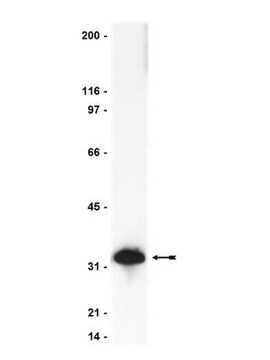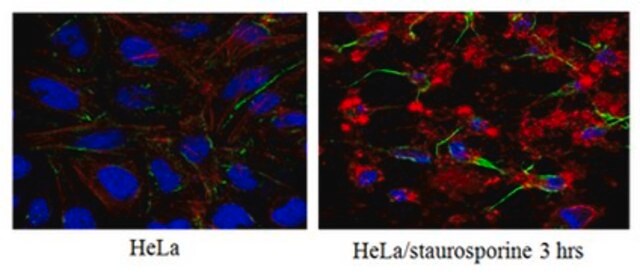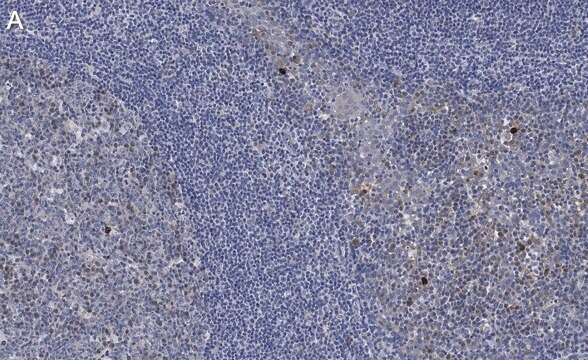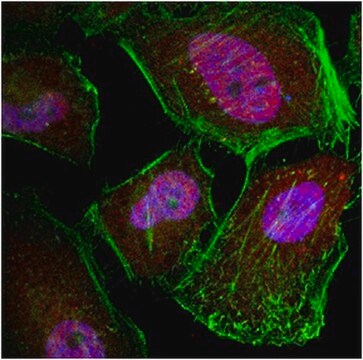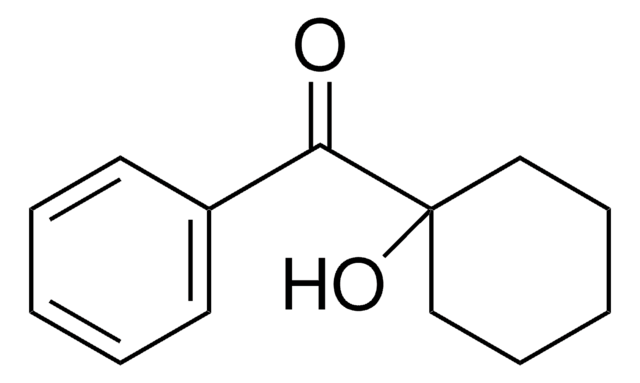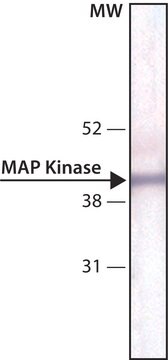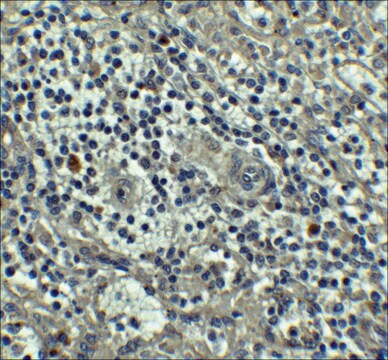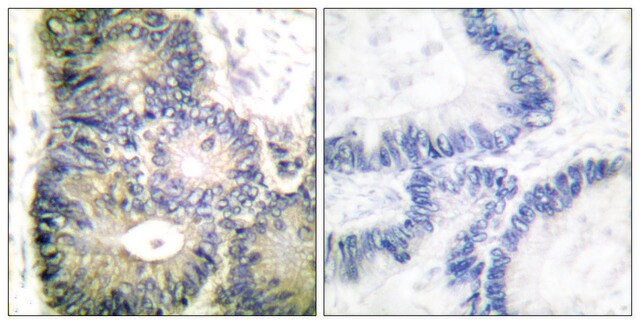C5737
Monoclonal Anti-Caspase 3 antibody produced in mouse
clone 84803.111, purified immunoglobulin, lyophilized powder
Synonym(e):
Anti-Apopain, Anti-CPP32, Anti-Yama
Anmeldenzur Ansicht organisationsspezifischer und vertraglich vereinbarter Preise
Alle Fotos(1)
About This Item
Empfohlene Produkte
Biologische Quelle
mouse
Qualitätsniveau
Konjugat
unconjugated
Antikörperform
purified immunoglobulin
Antikörper-Produkttyp
primary antibodies
Klon
84803.111, monoclonal
Form
lyophilized powder
Speziesreaktivität
human
Methode(n)
western blot: 1.0 μg/mL using human Jurkat cells
Isotyp
IgG2b
UniProt-Hinterlegungsnummer
Lagertemp.
−20°C
Posttranslationale Modifikation Target
unmodified
Angaben zum Gen
human ... CASP3(836)
Verwandte Kategorien
Allgemeine Beschreibung
CASP3 (caspase 3) is a cysteine protease belonging to the caspase protein family, and is related to interleukin-1β-converting enzyme (ICE). It is the human homologue of Caenorhabditis elegans Ced-3 protein. This protein forms a key element of apoptosis.
Spezifität
Detects recombinant human precursor caspase 3 and the 18 kDa form produced during apoptosis.
Immunogen
recombinant 18 kDa subunit, amino acids 29-175, of human caspase 3.
Biochem./physiol. Wirkung
CASP3 (caspase 3) is an essential protein of apoptosis, which includes multiple death-inducing signals, and caspase 3 functions at the last steps of programmed cell death. This protein is shown to be expressed in esophageal squamous cell carcinoma (ESCC), and its down-regulation is related to increased malignancy and reduced overall survival. Its expression in metastatic lymph nodes (LN) might serve as a marker for poor survival prognosis in patients with resected ESCC and metastasis to LN. Studies in multiple cancers such as, gastric, colorectal, ovarian and cervical cancers show that aberrant expression of this gene is linked with cancer progression and aggressive behavior. It might have potential as a marker to determine the prognosis of the above cancers.
Physikalische Form
Lyophilized from a 0.2 μm filtered solution in 0.01 M phosphate buffered saline with 5% trehalose.
Haftungsausschluss
Unless otherwise stated in our catalog or other company documentation accompanying the product(s), our products are intended for research use only and are not to be used for any other purpose, which includes but is not limited to, unauthorized commercial uses, in vitro diagnostic uses, ex vivo or in vivo therapeutic uses or any type of consumption or application to humans or animals.
Sie haben nicht das passende Produkt gefunden?
Probieren Sie unser Produkt-Auswahlhilfe. aus.
Empfehlung
Produkt-Nr.
Beschreibung
Preisangaben
Lagerklassenschlüssel
11 - Combustible Solids
WGK
WGK 1
Flammpunkt (°F)
Not applicable
Flammpunkt (°C)
Not applicable
Hier finden Sie alle aktuellen Versionen:
Besitzen Sie dieses Produkt bereits?
In der Dokumentenbibliothek finden Sie die Dokumentation zu den Produkten, die Sie kürzlich erworben haben.
Kunden haben sich ebenfalls angesehen
Qian Hu et al.
International journal of clinical and experimental pathology, 7(8), 5057-5070 (2014-09-10)
Emerging evidence has indicated that apoptotic cells have a compensatory effect on the proliferation of neighboring cells. Recent studies have shown that apoptotic tumor cells stimulate the repopulation of tumors from a small number of surviving cells by cleaved caspase-3
Xiu-Shen Wang et al.
World journal of gastroenterology, 20(15), 4414-4420 (2014-04-26)
To assess whether differential expression of caspase-3 in paired metastatic lymph nodes (LNs) is prognostic of survival in patients with resectable esophageal squamous cell carcinoma (ESCC). Capases-3 expression was evaluated immunohistochemically in 122 pairs of primary ESCCs and regional metastatic
Tingting Gu et al.
Oncology letters, 14(6), 6815-6822 (2018-02-10)
The present study explored the expression of tetraspanin 1 (TSPAN1) in esophageal carcinoma (EC) and its association with clinicopathological factors. TSPAN1 small interfering RNA (siRNA) was designed to target the TSPAN1 gene in Eca-109 cells in order to explore the
Chuandong Zhu et al.
Oncology letters, 15(4), 4221-4228 (2018-03-20)
The high atomic number of gold nanoparticles (GNPs) enables them to offer potential as practical and efficient radiosensitizing agents for cancer radiotherapy applications. In the present study, it was demonstrated that GNPs can significantly modulate the irradiation response of hepatocellular
Javier Marqués et al.
Antioxidants (Basel, Switzerland), 11(11) (2022-11-12)
NADPH oxidases (NOX) constitute the main reactive oxygen species (ROS) source in blood vessels. An oxidative stress situation due to ROS overproduction can lead into endothelial dysfunction, a molecular mechanism that precedes cardiovascular diseases (CVDs) such as atherosclerosis, myocardial infarction
Unser Team von Wissenschaftlern verfügt über Erfahrung in allen Forschungsbereichen einschließlich Life Science, Materialwissenschaften, chemischer Synthese, Chromatographie, Analytik und vielen mehr..
Setzen Sie sich mit dem technischen Dienst in Verbindung.
